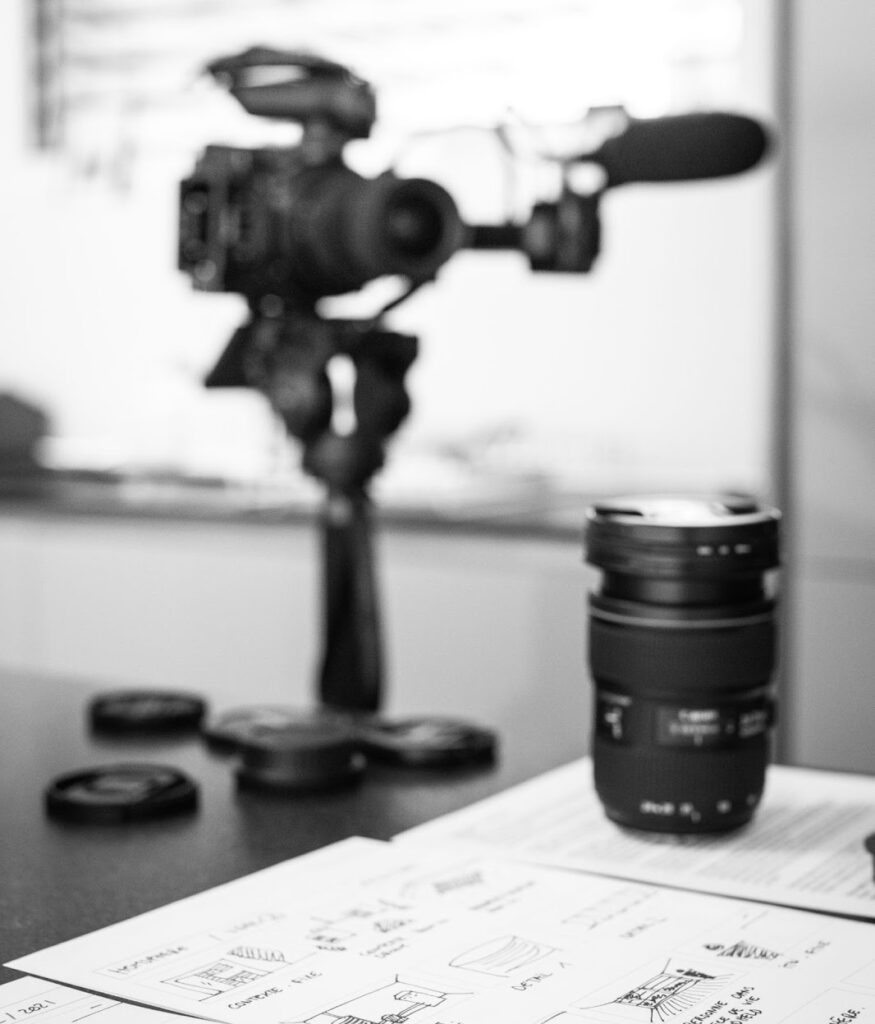Video Production Planning: Crafting
Quality through Communication
Tien Louis-Goff, Studio Manager/Lead Cinematographer
In order to create the most effective and powerful videos for your client, having consistency of vision and messaging from start to finish is critical. In this guide, we’ll explore the importance of communicating with the client before, during, and after video production to ensure and maintain quality control in the final cut.
Pre-Production Communication: Setting the Stage for Success
Before the cameras start rolling, establishing a strong line of communication with the client is crucial. Here’s how to ensure you’re on the same page from the very beginning:
a. Project Briefing:
In your initial call with the client, you should walk away from the discussion with some groundwork understanding of the client’s goals, objectives, and target audience. Ask detailed questions to gain insights into their vision, message, and expectations. Using that information, you can work with your client to set up video production dates, gather any client-sourced media such as archive content and logos/ branding materials, and move forward with creative collaboration to elevate the stylistic approach toward the filming execution.

b. Creative Collaboration:
Initiate collaboration through designated channels. Begin a project email thread to centralize planning communications. Identify key points of contact and ensure their inclusion in all correspondence. Concurrently, establish a shared project document. This dynamic space will house production requirements, action items, messaging, interview queries, and tentative schedules. Envision it as a collaborative hub. Partner with the client for idea generation, molding a captivating concept in line with their vision. Employ pre-production tools like mood boards, storyboards, and sample videos to fuel creative brainstorming.
c. Project Timeline:
Clearly outline the production timeline, including pre-production meetings, milestones such as script completion, production dates and post-production schedule. Address any potential challenges, blackout dates, or adjustments that might arise during the production process.

Communication During Production: Turning Vision into Reality
This is where the magic is captured. In order to have the ship running smoothly, ensure the on-set team understands their clearly defined roles and responsibilities. Communication is key in order to capture your critical content path, but also to allow creative liberties and necessary problem-solving.
a. One vision, one voice:
In filmmaking, you need to be a sponge. Great ideas and problem-solving can come from anywhere, but you must also stay focused with the client’s vision at the heart of every action and captured moment. Manage on-site direction so that every element serves the vision, and if you delegate this responsibility elsewhere, ensure there is a proper script and schedule being followed so that conflicts don’t arise and time is not lost. If you are conducting an interview, practice follow-up questions that hone in on the core messaging. Make sure your client has provided input on all of the creative elements so the production day can run efficiently and effectively.
b. Problem-Solving Together:
Challenges may arise during production, but not to worry. With so many folks involved and so many variables, things may need to change, and you’ll have to think on your feet to solve real-time problems. Discuss your approach with your team and involve the client in the decision-making process. Propose solutions and seek their input to ensure that the final product aligns with their expectations.
Post-Production Communication: Perfecting the Final Product
After the video production wraps, maintaining communication is just as vital during the editing phase:
a. Quality Control:
Prioritize quality control by meticulously reviewing all drafts of the edit for any errors, inconsistencies, or technical issues. Present the client with a polished version that meets or exceeds their expectations.
b. Revisions and Feedback:
Encourage the client to provide specific feedback on the edit, addressing aspects such as pacing, visuals, and messaging. Keep the lines of communication open to ensure their vision is being accurately reflected, and communicate the needed changes clearly to your editor in order to meet the client’s needs.
Post-Project Follow-Up: Sustaining Relationships
The journey doesn’t end when the project wraps. Cultivate lasting relationships by maintaining communication after the project concludes:
a. Evaluation and Reflection:
Schedule a post-project debrief with the client to discuss the entire production process. Gather their insights and feedback to improve future collaborations.
b. Sharing Success:
Once the video is ready for public release, celebrate the project going live together. Promote the video across social media platforms and showcase the collaborative effort that went into its creation.
c. Future Endeavors:
Express interest in working with the client again on future projects. Nurture the relationship by staying in touch and demonstrating your commitment to their creative endeavors.
Effective communication is key for video success. Set clear channels before, during, and after production for a shared vision, fewer hiccups, and top-notch videos that will wow clients. This teamwork and ongoing dialogue pave the way for future success!
